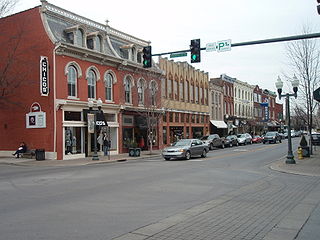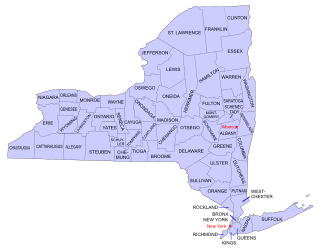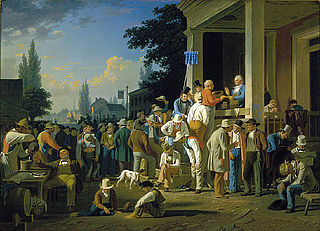
Williamson County is a county in the U.S. state of Tennessee. As of the 2020 United States census, the population was 247,726. The county seat is Franklin, and the county is located in Middle Tennessee. The county is named after Hugh Williamson, a North Carolina politician who signed the U.S. Constitution. Adjusted for relative cost of living, Williamson County is one of the wealthiest counties in the United States. Williamson County is part of the Nashville-Davidson–Murfreesboro–Franklin, TN Metropolitan Statistical Area. In the 19th century, tobacco and hemp were cultivated here, and planters also raised blooded livestock, including horses and cattle.

Franklin is a city in and county seat of Williamson County, Tennessee, United States. About 21 miles (34 km) south of Nashville, it is one of the principal cities of the Nashville metropolitan area and Middle Tennessee. As of 2020, its population was 83,454. It is the seventh-largest city in Tennessee. Franklin is known to be the home of many celebrities, mostly country music stars.

Shiloh National Military Park preserves the American Civil War Shiloh and Corinth battlefields. The main section of the park is in the unincorporated town of Shiloh, about nine miles (14 km) south of Savannah, Tennessee, with an additional area located in the city of Corinth, Mississippi, 23 miles (37 km) southwest of Shiloh. The Battle of Shiloh began a six-month struggle for the key railroad junction at Corinth. Afterward, Union forces marched from Pittsburg Landing to take Corinth in a May siege, then withstood an October Confederate counter-attack.

Buildings, sites, districts, and objects in New York listed on the National Register of Historic Places:
This is a list of the National Register of Historic Places listings in Knox County, Tennessee.
Franklin Battlefield was the site of the Second Battle of Franklin, which occurred late in the American Civil War. It is located in the southern part of Franklin, Tennessee, on U.S. 31. It was declared a National Historic Landmark in 1960.

This is a list of the National Register of Historic Places listings in Bristol, Virginia.

Old Town is an archaeological site in Williamson County, Tennessee near Franklin. The site includes the remnants of a Native American village and mound complex of the Mississippian culture, and is listed on the National Register of Historic Places (NRHP) as Old Town Archaeological Site (40WM2).

The Baumann family was a family of American architects who practiced in Knoxville, Tennessee, and the surrounding region, in the late 19th and early 20th centuries. It included Joseph F. Baumann (1844–1920), his brother, Albert B. Baumann, Sr. (1861–1942), and Albert's son, Albert B. Baumann, Jr. (1897–1952). Buildings designed by the Baumanns include the Mall Building (1875), the Church of the Immaculate Conception (1886), Minvilla (1913), the Andrew Johnson Building (1930), and the Knoxville Post Office (1934).
Hincheyville Historic District is a 53-acre (21 ha) historic district in Franklin, Tennessee. It is one of seven local historic districts in Franklin and was listed on the National Register of Historic Places in 1982, with boundary revisions in 2020.

Burwood, Tennessee is an unincorporated community in southwestern Williamson County, Tennessee.

Franklin Historic District is a historic district in Franklin, Tennessee that was listed on the National Register of Historic Places in 1972. It was created to preserve historic commercial and residential architecture in a 16-block area of the original, downtown Franklin around the north, west, and south of the town square.
Natchez Street Historic District is a 25-acre (10 ha) historic district in Franklin, Tennessee that was listed on the National Register of Historic Places in 2004.

Harlinsdale Farm is a 198-acre (80 ha) historic district in Franklin, Tennessee that was listed on the National Register of Historic Places in 2006. It dates from c.1900 and had other significant dates in 1935 and 1945.

The Toussaint L'Ouverture County Cemetery is an historical African-American cemetery located in Franklin, Tennessee. It was listed on the National Register of Historic Places in 1995. It is named for Toussaint Louverture, the leader of the Haitian Revolution. The earliest recorded burials date from 1869, but it wasn't officially incorporated until 1884. It is "the oldest African American institution in continuous use" in Williamson County.
Riverview Mounds Archaeological Site (40MT44), also known as the Rinehart Acres, is an archaeological site of the Mississippian culture located south of Clarksville in Montgomery County, Tennessee, on the eastern shore of the Cumberland River. The site was inhabited from approximately 1000 to 1500 CE.

The Rest Haven Cemetery in Franklin, Tennessee is a 7-acre (2.8 ha) cemetery that was listed on the National Register of Historic Places in 2012.

The Boonslick, or Boone's Lick Country, is a cultural region of Missouri along the Missouri River that played an important role in the westward expansion of the United States and the development of Missouri's statehood in the early 19th century. The Boone's Lick Road, a route paralleling the north bank of the river between St. Charles and Franklin, Missouri, was the primary thoroughfare for settlers moving westward from St. Louis in the early 19th century. Its terminus in Franklin marked the beginning of the Santa Fe Trail, which eventually became a major conduit for Spanish trade in the Southwestern United States. Later it connected to the large emigrant trails, including the Oregon and California Trails, used by pioneers, gold-seekers and other early settlers of the West. The region takes its name from a salt spring or "lick" in western Howard County, used by Nathan and Daniel Morgan Boone, sons of famed frontiersman Daniel Boone.

Adelia Armstrong Lutz was an American artist active in the late nineteenth and early twentieth centuries. She organized art circles in Knoxville, Tennessee, as director of the Knoxville Art Club and as a co-organizer of the Nicholson Art League. Her still lifes and portraits were exhibited throughout the American South, and they are to be the subject of a permanent exhibit at her former home, Historic Westwood.














